torque MITSUBISHI SPYDER 1990 Service Repair Manual
[x] Cancel search | Manufacturer: MITSUBISHI, Model Year: 1990, Model line: SPYDER, Model: MITSUBISHI SPYDER 1990Pages: 2103, PDF Size: 68.98 MB
Page 1164 of 2103

AUTOMATIC TRANSAXLE
ENGINE (NON-TURBO)> Troubleshooting
Trouble symptom
torque converter control shift
PROBABLE CAUSE
No.Probable cause
18Drive shaft(s) bushing(s) worn or damaged
19Worn or broken reaction shaft support sealing
20Worn or damaged input shaft sealing
21Valve body malfunction or leakage
22Hydraulic pressure too low
23Hydraulic pressure too high
24 Faulty oil pump
25Oil filter clogged
26Low fluid level
27 High fluid level
28Aerated fluid
29 Engine idle too low
30Engine idle too high
31Normal solenoid operation
32Solenoid sound cover loose
33Sticking lockup piston
34 Torque converter failure
TSB Revision
Page 1174 of 2103
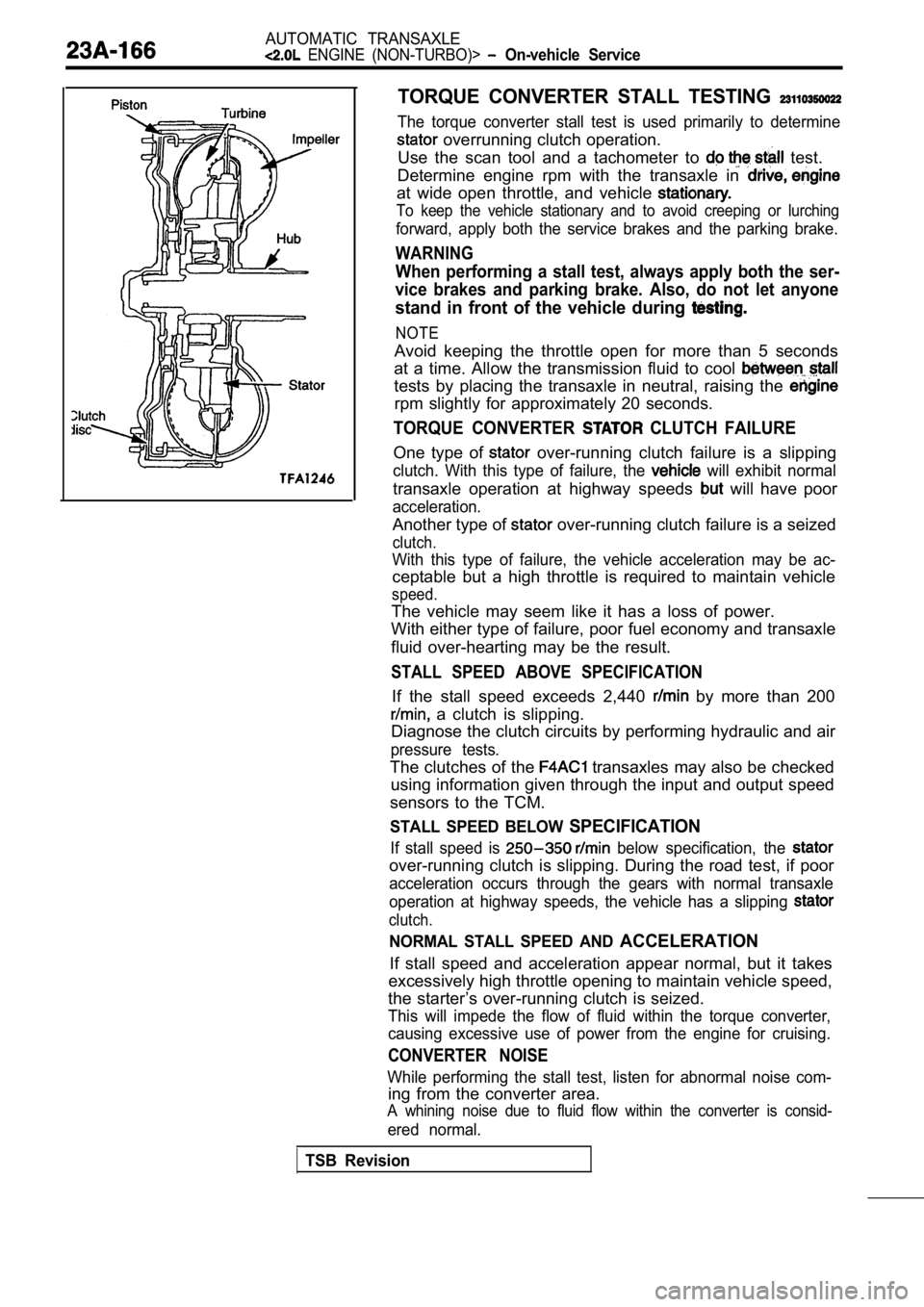
AUTOMATIC TRANSAXLE
ENGINE (NON-TURBO)> On-vehicle Service
TORQUE CONVERTER STALL TESTING
The torque converter stall test is used primarily to determine
overrunning clutch operation.
Use the scan tool and a tachometer to
test.
Determine engine rpm with the transaxle in
at wide open throttle, and vehicle
To keep the vehicle stationary and to avoid creepin g or lurching
forward, apply both the service brakes and the parking brake.
WARNING
When performing a stall test, always apply both the ser-
vice brakes and parking brake. Also, do not let any one
stand in front of the vehicle during
NOTE
Avoid keeping the throttle open for more than 5 seconds
at a time. Allow the transmission fluid to cool
tests by placing the transaxle in neutral, raising the
rpm slightly for approximately 20 seconds.
TORQUE CONVERTER CLUTCH FAILURE
One type of over-running clutch failure is a slipping
clutch. With this type of failure, the will exhibit normal
transaxle operation at highway speeds will have poor
acceleration.
Another type of over-running clutch failure is a seized
clutch.
With this type of failure, the vehicle acceleration may be ac-
ceptable but a high throttle is required to maintai n vehicle
speed.
The vehicle may seem like it has a loss of power.
With either type of failure, poor fuel economy and transaxle
fluid over-hearting may be the result.
STALL SPEED ABOVE SPECIFICATION
If the stall speed exceeds 2,440 by more than 200
a clutch is slipping.
Diagnose the clutch circuits by performing hydrauli c and air
pressure tests.
The clutches of the transaxles may also be checked
using information given through the input and outpu t speed
sensors to the TCM.
STALL SPEED BELOW SPECIFICATION
If stall speed is below specification, the
over-running clutch is slipping. During the road te st, if poor
acceleration occurs through the gears with normal t ransaxle
operation at highway speeds, the vehicle has a slip ping
clutch.
NORMAL STALL SPEED AND ACCELERATION
If stall speed and acceleration appear normal, but it takes
excessively high throttle opening to maintain vehic le speed,
the starter’s over-running clutch is seized.
This will impede the flow of fluid within the torqu e converter,
causing excessive use of power from the engine for cruising.
CONVERTER NOISE
While performing the stall test, listen for abnormal noise com-
ing from the converter area.
A whining noise due to fluid flow within the conver ter is consid-
ered normal.
TSB Revision
Page 1175 of 2103
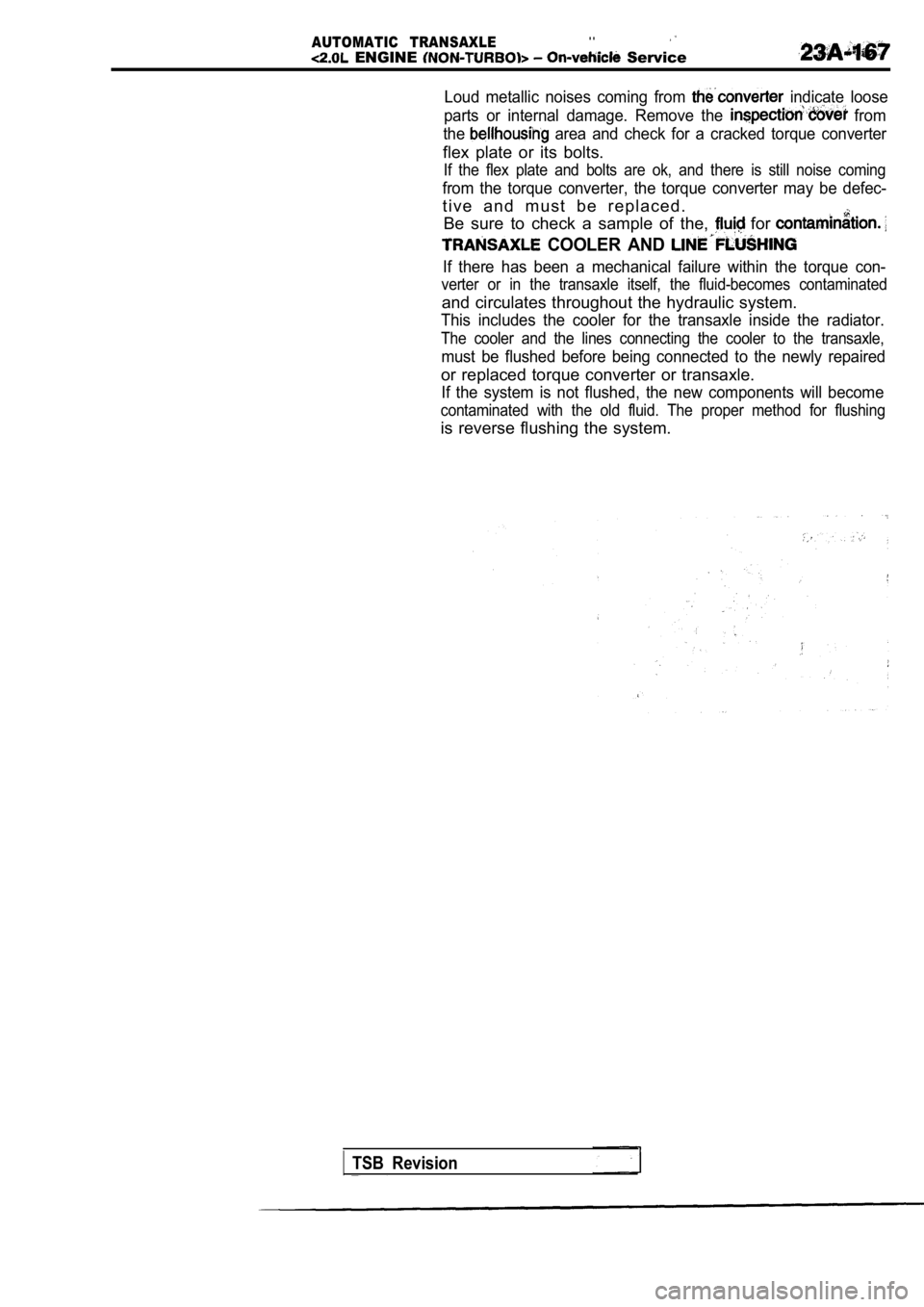
AUTOMATIC TRANSAXLE. .
ENGINE Service
Loud metallic noises coming from indicate loose
parts or internal damage. Remove the
from
the
area and check for a cracked torque converter
flex plate or its bolts.
If the flex plate and bolts are ok, and there is st ill noise coming
from the torque converter, the torque converter may be defec-
t i v e a n d m u s t b e r e p l a c e d .
Be sure to check a sample of the,
for
COOLER AND
If there has been a mechanical failure within the t orque con-
verter or in the transaxle itself, the fluid-becomes contaminated
and circulates throughout the hydraulic system.
This includes the cooler for the transaxle inside t he radiator.
The cooler and the lines connecting the cooler to t he transaxle,
must be flushed before being connected to the newly repaired
or replaced torque converter or transaxle.
If the system is not flushed, the new components will become
contaminated with the old fluid. The proper method for flushing
is reverse flushing the system.
TSB Revision
Page 1176 of 2103
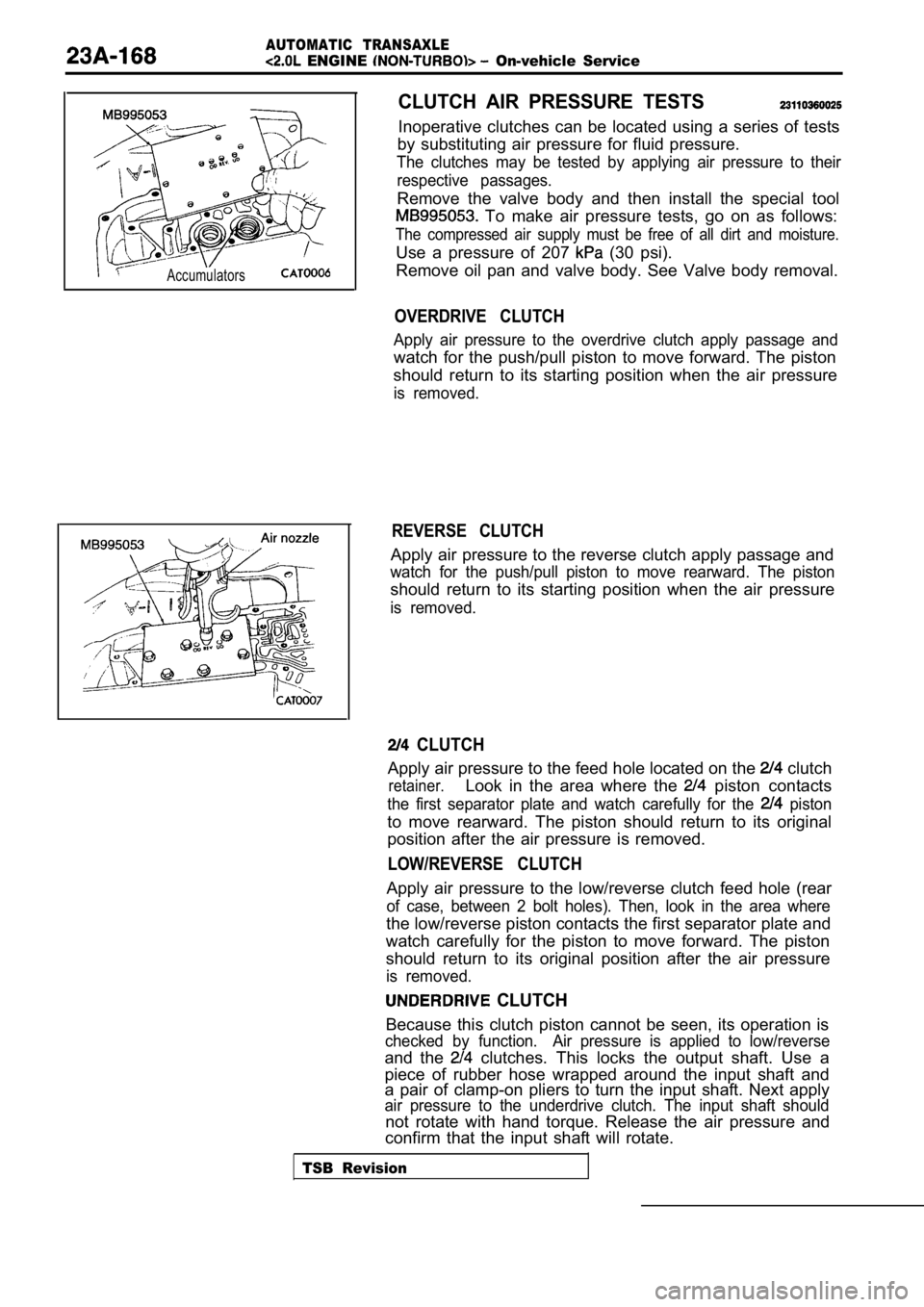
AUTOMATIC TRANSAXLE
ENGINE On-vehicle Service
Accumulators
CLUTCH AIR PRESSURE TESTS
Inoperative clutches can be located using a series of tests
by substituting air pressure for fluid pressure.
The clutches may be tested by applying air pressure to their
respective passages.
Remove the valve body and then install the special tool
To make air pressure tests, go on as follows:
The compressed air supply must be free of all dirt and moisture.
Use a pressure of 207 (30 psi).
Remove oil pan and valve body. See Valve body remov al.
OVERDRIVE CLUTCH
Apply air pressure to the overdrive clutch apply passage and
watch for the push/pull piston to move forward. The piston
should return to its starting position when the air pressure
is removed.
REVERSE CLUTCH
Apply air pressure to the reverse clutch apply pass age and
watch for the push/pull piston to move rearward. Th e piston
should return to its starting position when the air pressure
is removed.
CLUTCH
Apply air pressure to the feed hole located on the clutch
retainer.Look in the area where the piston contacts
the first separator plate and watch carefully for the piston
to move rearward. The piston should return to its o riginal
position after the air pressure is removed.
LOW/REVERSE CLUTCH
Apply air pressure to the low/reverse clutch feed h ole (rear
of case, between 2 bolt holes). Then, look in the a rea where
the low/reverse piston contacts the first separator plate and
watch carefully for the piston to move forward. The piston
should return to its original position after the ai r pressure
is removed.
CLUTCH
Because this clutch piston cannot be seen, its oper ation is
checked by function. Air pressure is applied to low/ reverse
and the clutches. This locks the output shaft. Use a
piece of rubber hose wrapped around the input shaft and
a pair of clamp-on pliers to turn the input shaft. Next apply
air pressure to the underdrive clutch. The input sh aft should
not rotate with hand torque. Release the air pressu re and
confirm that the input shaft will rotate.
TSB Revision
Page 1177 of 2103
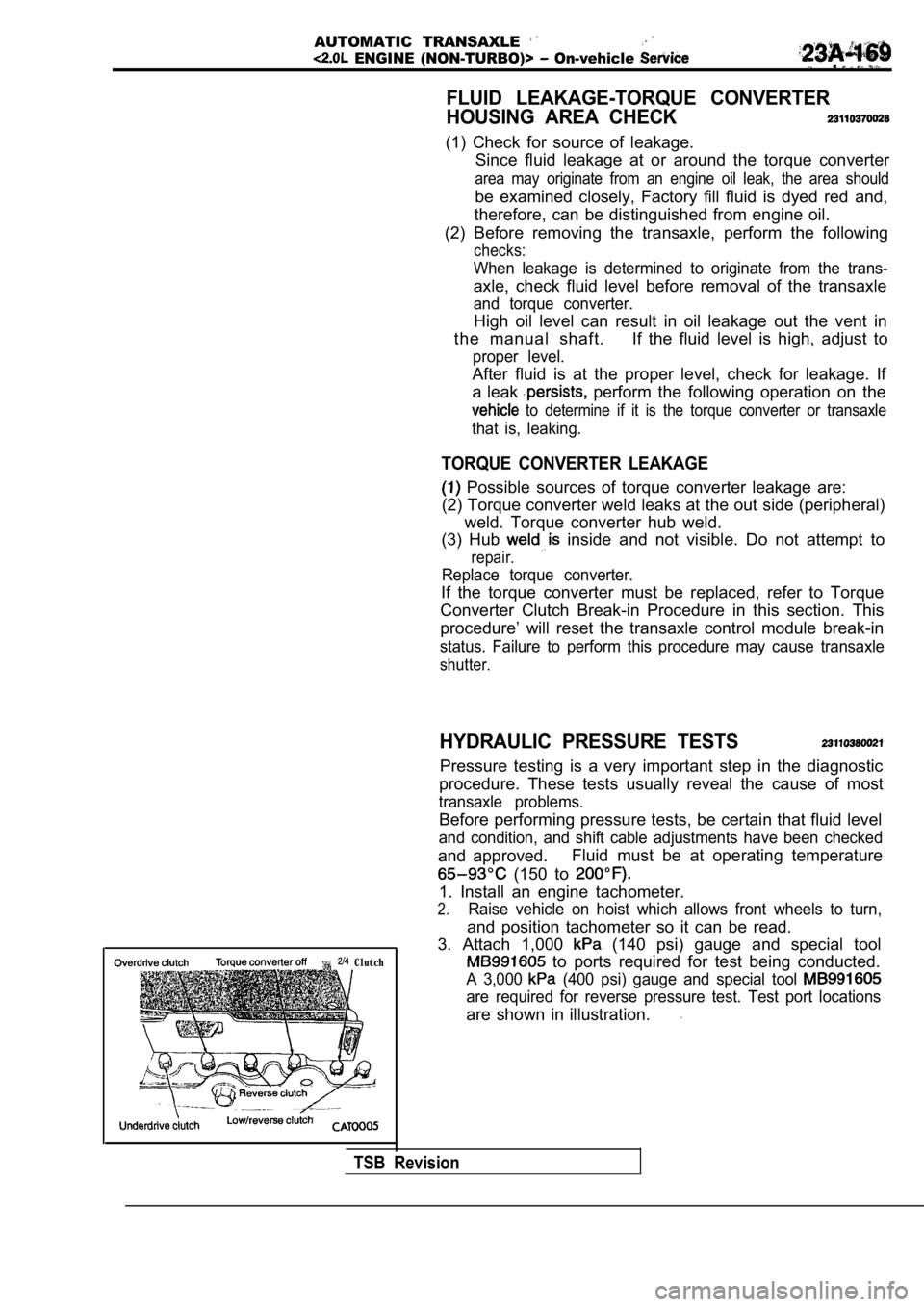
AUTOMATIC TRANSAXLE
ENGINE (NON-TURBO)> On-vehicle .
FLUID LEAKAGE-TORQUE CONVERTER
HOUSING AREA CHECK
(1) Check for source of leakage.Since fluid leakage at or around the torque convert er
area may originate from an engine oil leak, the area should
be examined closely, Factory fill fluid is dyed red and,
therefore, can be distinguished from engine oil.
(2) Before removing the transaxle, perform the foll owing
checks:
When leakage is determined to originate from the tr ans-
axle, check fluid level before removal of the transaxle
and torque converter.
High oil level can result in oil leakage out the vent in
the manual shaft. If the fluid level is high, adjust to
proper level.
After fluid is at the proper level, check for leakage. If
a leak
perform the following operation on the
to determine if it is the torque converter or tran saxle
that is, leaking.
TORQUE CONVERTER LEAKAGE
Possible sources of torque converter leakage are:
(2) Torque converter weld leaks at the out side (pe ripheral)
weld. Torque converter hub weld.
(3) Hub
inside and not visible. Do not attempt to
repair.
Replace torque converter.
If the torque converter must be replaced, refer to Torque
Converter Clutch Break-in Procedure in this section . This
procedure’ will reset the transaxle control module break-in
status. Failure to perform this procedure may cause transaxle
shutter.
Clutch
HYDRAULIC PRESSURE TESTS
Pressure testing is a very important step in the diagnostic
procedure. These tests usually reveal the cause of most
transaxle problems.
Before performing pressure tests, be certain that fluid level
and condition, and shift cable adjustments have bee n checked
and approved.Fluid must be at operating temperature
(150 to
1. Install an engine tachometer.
2.Raise vehicle on hoist which allows front wheels to
turn,
and position tachometer so it can be read.
3. Attach 1,000
(140 psi) gauge and special tool
to ports required for test being conducted.
A 3,000 (400 psi) gauge and special tool
are required for reverse pressure test. Test port l ocations
are shown in illustration.
TSB Revision
Page 1179 of 2103
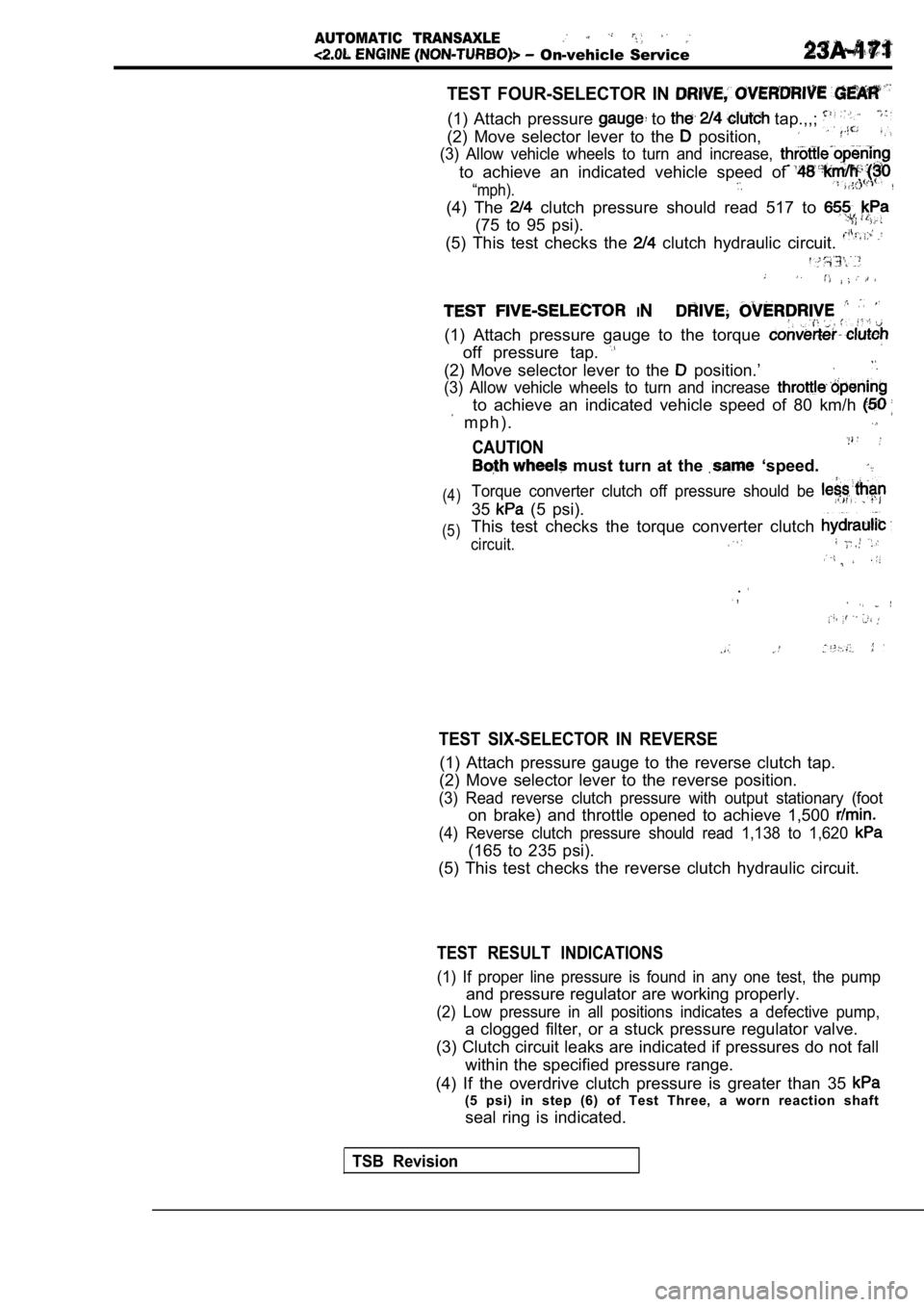
AUTOMATIC TRANSAXLE
On-vehicle Service
TEST FOUR-SELECTOR IN
(1) Attach pressure to tap.,,;
(2) Move selector lever to the position,
(3) Allow vehicle wheels to turn and increase,
to achieve an indicated vehicle speed of
“mph).
(4) The clutch pressure should read 517 to
(75 to 95 psi).
(5) This test checks the clutch hydraulic circuit.
IN
(1) Attach pressure gauge to the torque
off pressure tap.
(2) Move selector lever to the position.’
(3) Allow vehicle wheels to turn and increase
to achieve an indicated vehicle speed of 80 km/h
m p h ) .
CAUTION
must turn at the ‘speed.
(4)
(5)Torque converter clutch off pressure should be
35 (5 psi).
This test checks the torque converter clutch
circuit.
. ,
TEST SIX-SELECTOR IN REVERSE
(1) Attach pressure gauge to the reverse clutch tap .
(2) Move selector lever to the reverse position.
(3) Read reverse clutch pressure with output statio nary (foot
on brake) and throttle opened to achieve 1,500
(4) Reverse clutch pressure should read 1,138 to 1, 620
(165 to 235 psi).
(5) This test checks the reverse clutch hydraulic c ircuit.
TEST RESULT INDICATIONS
(1) If proper line pressure is found in any one test, the pump
and pressure regulator are working properly.
(2) Low pressure in all positions indicates a defec tive pump,
a clogged filter, or a stuck pressure regulator valve.
(3) Clutch circuit leaks are indicated if pressures do not fall
within the specified pressure range.
(4) If the overdrive clutch pressure is greater tha n 35
(5 psi) in step (6) of Test Three, a worn reaction shaft
seal ring is indicated.
TSB Revision
Page 1201 of 2103
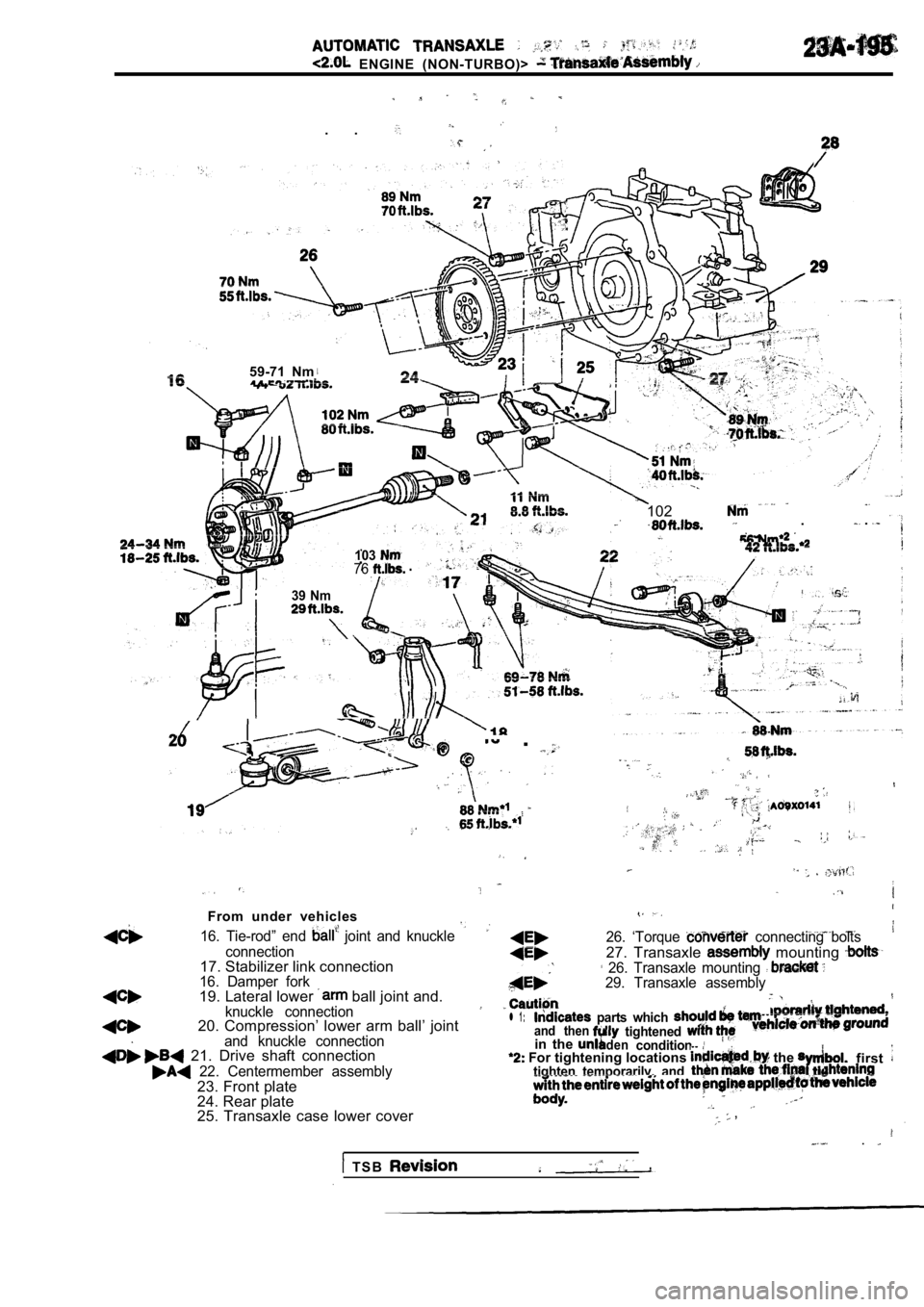
ENGINE (NON-TURBO)>
. .
59-71 Nm --
102. .
10376
39 Nm
2 .
From under vehicles
16. Tie-rod” end joint and knuckle 26. ‘Torque connecting bolts
27. Transaxle mounting 26. Transaxle mounting 29. Transaxle assembly
connection17. Stabilizer link connection16. Damper fork19. Lateral lower ball joint and.knuckle connection20. Compression’ lower arm ball’ jointl 1 parts which and thenand knuckle connection 21. Drive shaft connectionin the tightened dencondition. For tightening locations the first 22. Centermember assemblytighten temporarily, and
23. Front plate24. Rear plate25. Transaxle case lower cover ,
.
T S B
Page 1203 of 2103
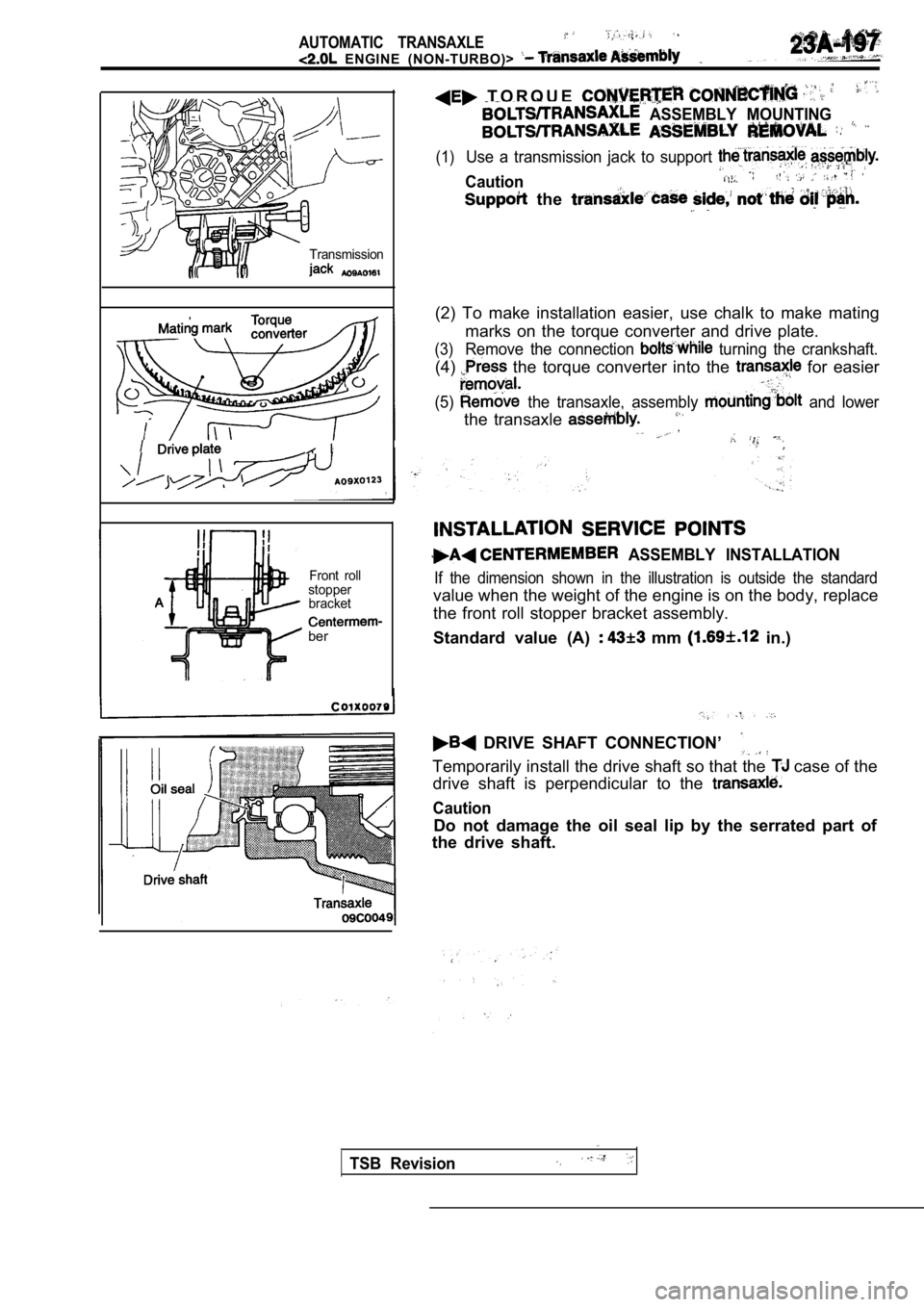
AUTOMATIC TRANSAXLE
ENGINE (NON-TURBO)>
Transmission
I
Front roll
stopper bracket
ber
T O R Q U E
ASSEMBLY MOUNTING
(1)Use a transmission jack to support
Caution
the
(2) To make installation easier, use chalk to make mating
marks on the torque converter and drive plate.
(3)Remove the connection turning the crankshaft.
(4) the torque converter into the for easier
(5) the transaxle, assembly and lower
the transaxle
ASSEMBLY INSTALLATION
If the dimension shown in the illustration is outsi de the standard
value when the weight of the engine is on the body, replace
the front roll stopper bracket assembly.
Standard value (A)
mm in.)
DRIVE SHAFT CONNECTION’
Temporarily install the drive shaft so that the case of the
drive shaft is perpendicular to the
Caution
Do not damage the oil seal lip by the serrated part of
the drive shaft.
TSB Revision
Page 1207 of 2103
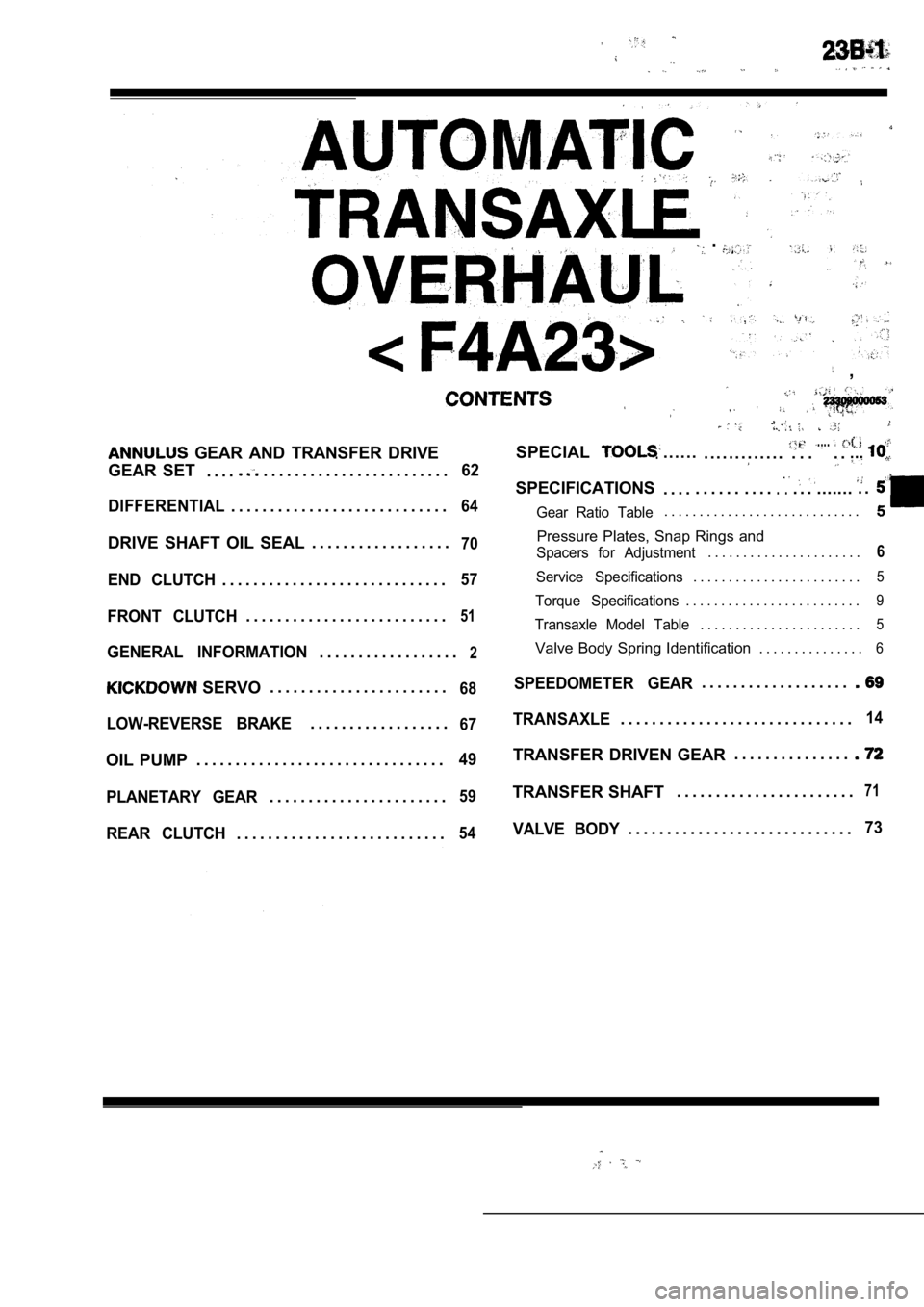
.
,
GEAR AND TRANSFER DRIVE
GEAR SET . . . .
. . . . . . . . . . . . . . . . . . . . . . . .62
DIFFERENTIAL
. . . . . . . . . . . . . . . . . . . . . . . . . . . .64
DRIVE SHAFT OIL SEAL . . . . . . . . . . . . . . . . . .70
END CLUTCH. . . . . . . . . . . . . . . . . . . . . . . . . . . . .57
FRONT CLUTCH. . . . . . . . . . . . . . . . . . . . . . . . . .51
GENERAL INFORMATION. . . . . . . . . . . . . . . . . .2
SERVO. . . . . . . . . . . . . . . . . . . . . . .68
LOW-REVERSE BRAKE. . . . . . . . . . . . . . . . . .67
OIL PUMP
. . . . . . . . . . . . . . . . . . . . . . . . . . . . . . . .49
PLANETARY GEAR
. . . . . . . . . . . . . . . . . . . . . . .59
REAR CLUTCH. . . . . . . . . . . . . . . . . . . . . . . . . . .54
SPECIAL. . . . . ... . . . . . . . . . . . .. . ...... ....
SPECIFICATIONS. . . . . . . . . . . . . .. .. . . ........ .
Gear Ratio Table. . . . . . . . . . . . . . . . . . . . . . . . . . . .
Pressure Plates, Snap Rings and
Spacers for Adjustment. . . . . . . . . . . . . . . . . . . . . .6
Service Specifications. . . . . . . . . . . . . . . . . . . . . . . .5
Torque Specifications. . . . . . . . . . . . . . . . . . . . . . . . .9
Transaxle Model Table. . . . . . . . . . . . . . . . . . . . . . .5
Valve Body Spring Identification . . . . . . . . . . . . . . .6
SPEEDOMETER GEAR. . . . . . . . . . . . . . . . . . .
TRANSAXLE. . . . . . . . . . . . . . . . . . . . . . . . . . . . . .14
TRANSFER DRIVEN GEAR . . . . . . . . . . . . . . .
TRANSFER SHAFT
. . . . . . . . . . . . . . . . . . . . . . .71
VALVE BODY. . . . . . . . . . . . . . . . . . . . . . . . . . . . .73
Page 1209 of 2103
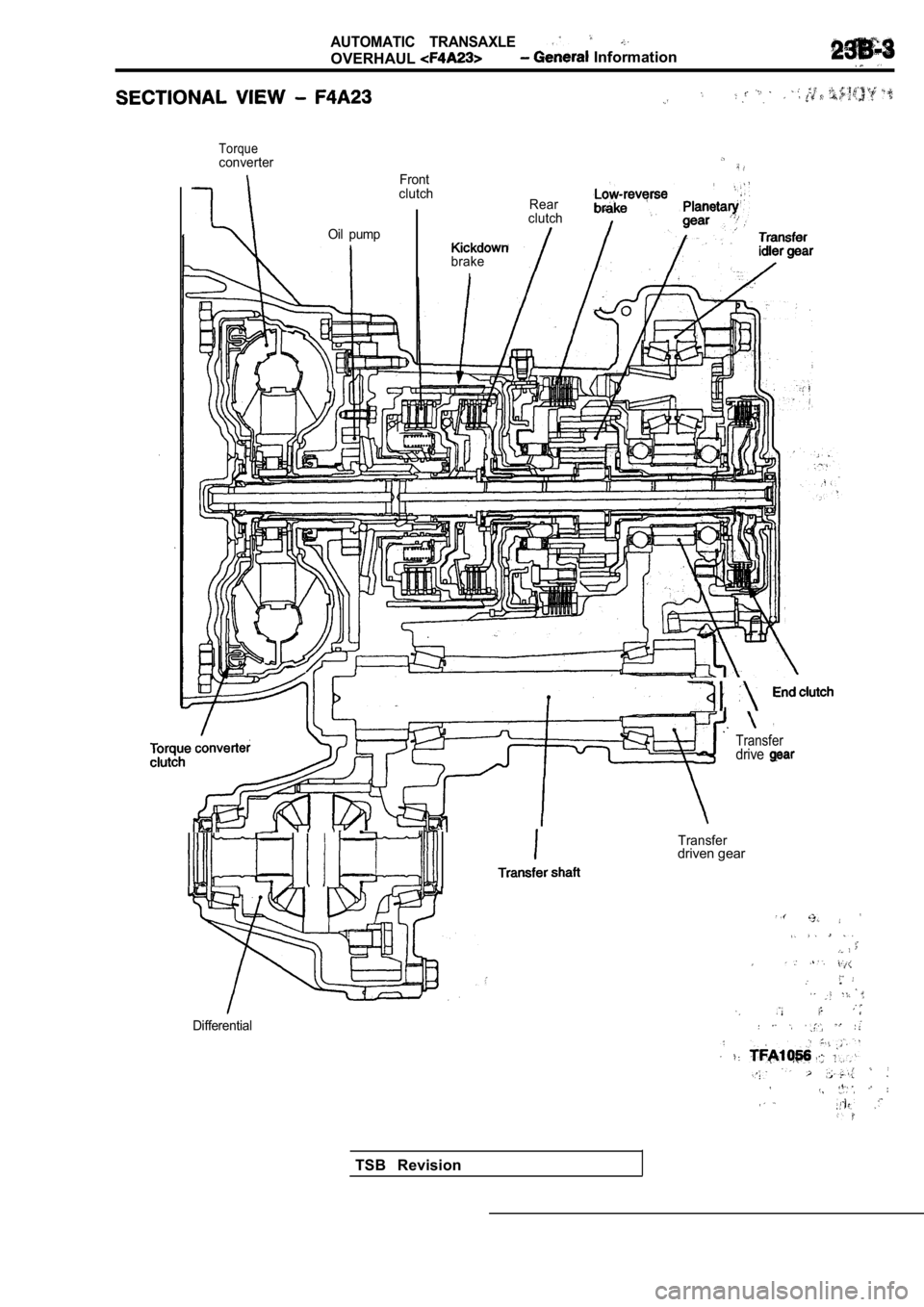
AUTOMATIC TRANSAXLE
OVERHAUL Information
Torqueconverter
Front
clutch Rear
clutch
Oil pump
brake
I
TSB Revision
Transferdrive
Transferdriven gear
Differential